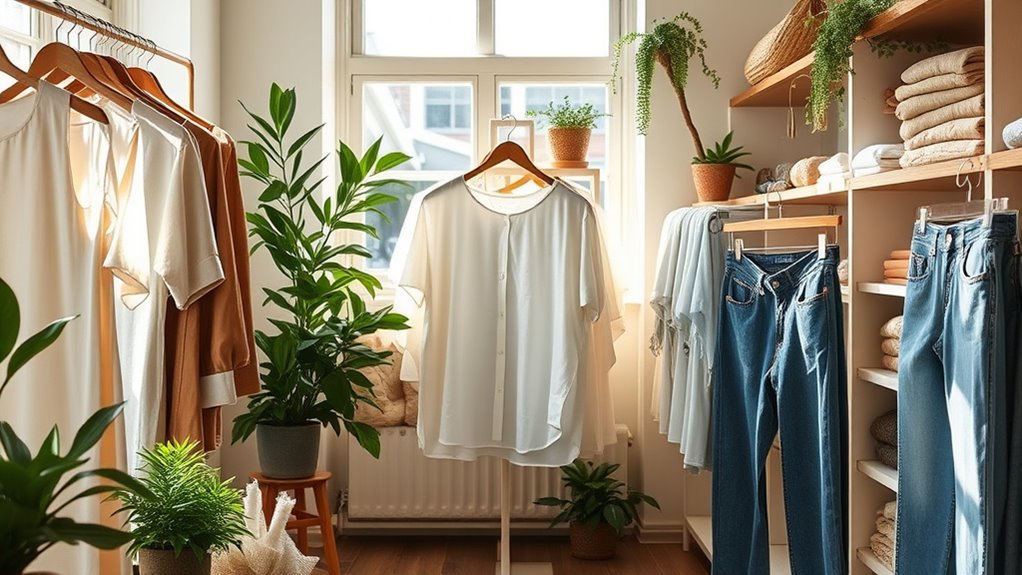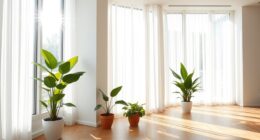To build a chic, sustainable wardrobe, focus on ethical brands that share transparent supply chains and fair labor practices. Choose timeless, versatile pieces in neutral colors and high-quality fabrics like organic cotton or linen, which endure trends and last longer. Regularly care for your garments to extend their life, and prioritize quality over quantity. By making thoughtful shopping choices and supporting responsible brands, you’ll create a stylish wardrobe that benefits both you and the planet—discover more tips below.
Key Takeaways
- Prioritize timeless, versatile pieces in neutral tones to create stylish looks that last beyond fleeting trends.
- Research brands’ ethical practices and transparency to ensure fair wages, sustainable sourcing, and responsible manufacturing.
- Invest in high-quality garments made from durable, eco-friendly fabrics to enhance longevity and reduce waste.
- Build your wardrobe thoughtfully by evaluating existing pieces for fit, function, and versatility before adding new items.
- Maintain your clothing properly through careful washing, storing, and repairing to extend its lifespan and maximize your investment.

Have you ever wondered how to build a wardrobe that’s stylish, sustainable, and lasts for years? The key is embracing slow fashion principles, which prioritize quality over quantity and focus on intentional choices. To start, you want to seek out brands and designers committed to ethical sourcing. When clothes are made with transparency about their supply chains, you can trust that workers are paid fairly and environmental standards are upheld. This commitment to ethical sourcing ensures your wardrobe isn’t just fashionable but also aligned with your values, reducing the impact on communities and ecosystems.
Next, focus on timeless designs. Trendy pieces fade quickly, but classic styles endure. Investing in versatile, well-constructed garments with clean lines and neutral colors means your wardrobe remains relevant season after season. These timeless designs don’t just make dressing easier; they also extend the lifespan of your clothes, reducing the need for frequent replacements. When your wardrobe is rooted in timeless pieces, you can mix and match effortlessly, creating countless outfits without feeling the pressure to chase every fleeting trend.
Building a wardrobe full of such pieces requires a thoughtful approach. Start by evaluating what you already own, identifying items that fit well, suit your lifestyle, and can be styled in multiple ways. Then, prioritize quality over quantity when shopping. It might mean spending more upfront, but durable fabrics like organic cotton, linen, or sustainably sourced wool pay off in the long run. Look for brands that emphasize craftsmanship and durability, and don’t be afraid to invest in a few high-quality staples rather than numerous disposable items.
Another essential aspect is doing your research. Learn about brands’ commitments to sustainability and ethical practices. Many companies now provide transparent information about their sourcing and manufacturing processes, making it easier to make informed choices. Shopping from local or small-scale producers can also support ethical practices and minimize environmental impact.
Additionally, understanding the benefits of curiosity can motivate you to explore new sustainable fabrics and innovative design practices, enriching your wardrobe choices. Finally, maintain your wardrobe with care. Proper washing, storing, and repairing extend the life of your clothes, making your investment last even longer. By choosing garments rooted in ethical sourcing and timeless designs, you’re creating a wardrobe that’s not only stylish but also sustainable and meaningful. Slow fashion isn’t about sacrificing style; it’s about making smarter, more conscious decisions that benefit you and the planet for years to come.
Frequently Asked Questions
How Do I Identify Truly Sustainable Clothing Brands?
To identify truly sustainable clothing brands, look for those committed to the circular economy, meaning they prioritize recycling, upcycling, or designing for longevity. Check if they uphold fair labor practices, ensuring fair wages and safe working conditions. Research their materials, transparency, and environmental policies. Brands that openly share their sustainability efforts and demonstrate accountability are more likely to be genuinely eco-friendly and socially responsible.
What Are Eco-Friendly Materials I Should Look For?
Think of eco-friendly materials as nature’s own treasures. You should look for organic fabrics like organic cotton and linen, which are grown without harmful chemicals. Recycled fibers, such as recycled polyester or nylon, give new life to waste and reduce pollution. These materials help you build a wardrobe that’s stylish and sustainable. By choosing eco-friendly fabrics, you’re making a conscious choice to support a healthier planet.
How Can I Upcycle or Repurpose Old Garments Effectively?
You can upcycle or repurpose old garments through creative transformations by exploring DIY hacks. Start by turning an old t-shirt into a tote bag or cutting jeans into stylish shorts. Use fabric dye to refresh faded fabrics, or add embellishments for a new look. With some imagination, you’ll breathe new life into your wardrobe while reducing waste and embracing sustainable fashion practices.
What Maintenance Tips Extend the Life of My Wardrobe Pieces?
Think of your wardrobe as a garden that needs regular tending. Keep it thriving with proper wardrobe organization, making it easy to find and care for each piece. Master stain removal techniques to keep garments looking fresh and vibrant. Regularly check for loose threads or hems, and follow washing instructions diligently. These small acts prolong your clothes’ lifespan, ensuring your wardrobe remains a beautiful, sustainable bloom season after season.
How Do I Balance Style Trends With Sustainability Goals?
To balance style trends with sustainability goals, focus on trend integration by choosing versatile pieces that can be styled in multiple ways. Prioritize quality over quantity, so your wardrobe remains timeless and eco-friendly. Mix trendy items with classic staples to stay current without overbuying. This approach enhances wardrobe versatility, allowing you to enjoy fashionable looks while supporting sustainable fashion practices. Stay intentional and mindful about each piece you add.
Conclusion
Building a sustainable wardrobe is like planting a garden—you nurture it patiently, and it blossoms into something beautiful and lasting. Every thoughtful choice you make adds to this vibrant landscape, creating a wardrobe that reflects your style and values. Remember, slow fashion isn’t just about the clothes you wear; it’s about cultivating a mindset that values quality over quantity. Keep tending your fashion garden, and watch it flourish with timeless elegance and purpose.










